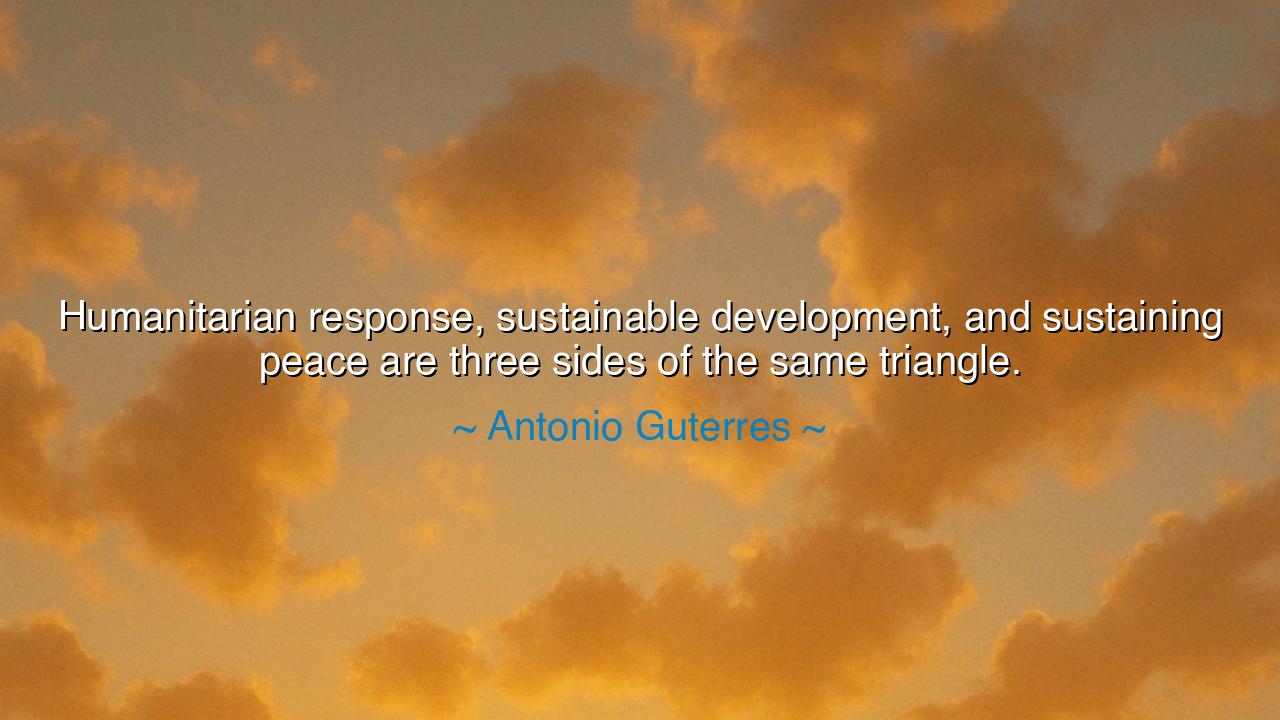
Humanitarian response, sustainable development, and sustaining
Humanitarian response, sustainable development, and sustaining peace are three sides of the same triangle.






Hear the words of António Guterres, Secretary-General of the United Nations, who speaks as one entrusted with the burdens of the world: “Humanitarian response, sustainable development, and sustaining peace are three sides of the same triangle. In this saying lies a vision as old as the wisdom of the ancients: that the struggles of humankind cannot be solved in fragments, but only in harmony. Just as a triangle cannot stand if one side is broken, so too does the world collapse if mercy, growth, and peace are divided.
The first side is the humanitarian response—the swift hand that feeds the hungry, heals the wounded, shelters the refugee. This is compassion in action, the urgent duty to aid those who suffer in times of war, famine, or disaster. Without it, humanity withers, for no society can endure if it leaves its most vulnerable to perish. Yet mercy alone cannot suffice, for if we feed the starving but do not mend the soil, hunger will return again. Thus, the triangle needs its second side.
The second side is sustainable development—the work of planting for tomorrow, of building schools, cultivating the land, shaping economies that endure. It is the wisdom of the farmer who does not only harvest, but sows for the next season. It is the vision of leaders who do not only repair, but build foundations so that generations may thrive. Yet development alone falters if it is pursued without peace, for no harvest flourishes in the fire of war. Thus, we come to the third side.
The third side is sustaining peace—the shield that guards all progress. Without peace, fields are burned, homes are lost, and communities unravel. Peace is not merely the silence of guns, but the steady rhythm of justice, the harmony of diverse peoples, the strength of trust among nations. When peace is sustained, both mercy and development can flourish. When it is broken, both collapse into ruin. Thus, Guterres reminds us: only when the three stand together does humanity stand secure.
History bears witness to this truth. After the Second World War, Europe lay in ashes. Humanitarian aid poured in to keep millions alive. But it was not enough to simply feed the hungry. Leaders sowed sustainable development through the Marshall Plan, rebuilding economies and infrastructure. At the same time, they forged alliances, treaties, and institutions that would secure peace and prevent another global catastrophe. Mercy, growth, and peace together formed a triangle that lifted a continent from despair to prosperity. Without any one of these, recovery would have failed.
The teaching here is clear: divide mercy from growth, or peace from either, and all will crumble. Too often, nations seek to heal wounds without changing the conditions that cause them, or they build riches without healing divisions, or they sign treaties without feeding the hungry. Such efforts cannot last. The triangle must remain whole, or else collapse will return.
So, children of tomorrow, take this wisdom into your lives. In your communities, your families, and your nations, remember the triangle. Offer compassion to those in need, but also build structures that endure. Work for justice and peace, for without them, your labors will be undone. And above all, remember that each side depends on the other. Just as a triangle is the strongest of shapes, so too is humanity strongest when mercy, growth, and peace stand together as one. This is the teaching of Guterres—a vision not only for nations, but for every soul who dares to heal, to build, and to preserve harmony in the world.






AAdministratorAdministrator
Welcome, honored guests. Please leave a comment, we will respond soon